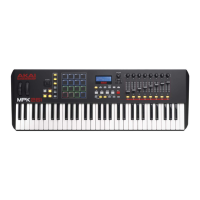
Do you have a question about the Akai MPK261 and is the answer not in the manual?
| MIDI-keyboard number of keys | 61 keys |
|---|---|
| Interface | USB |
| USB version | 2.0 |
| USB ports quantity | 1 |
| Minimum RAM | 1024 MB |
| Minimum processor | 1.25GHz G4 & G5 / 1.5GHz Pentium 4 & Celeron |
| Windows operating systems supported | Windows 7 Home Basic, Windows 7 Home Basic x64, Windows 7 Home Premium, Windows 7 Home Premium x64, Windows 7 Professional, Windows 7 Professional x64, Windows 7 Starter, Windows 7 Starter x64, Windows 7 Ultimate, Windows 7 Ultimate x64, Windows 8, Windows 8 Enterprise, Windows 8 Enterprise x64, Windows 8 Pro, Windows 8 Pro x64, Windows 8 x64, Windows Vista Business, Windows Vista Business x64, Windows Vista Enterprise, Windows Vista Enterprise x64, Windows Vista Home Basic, Windows Vista Home Basic x64, Windows Vista Home Premium, Windows Vista Home Premium x64, Windows Vista Ultimate, Windows Vista Ultimate x64, Windows XP Home, Windows XP Home x64, Windows XP Professional, Windows XP Professional x64 |
| Depth | 311 mm |
|---|---|
| Width | 905 mm |
| Height | 86 mm |
| Weight | 6850 g |
List of items included in the MPK261 package.
Overview of the four primary operational modes: Preset, Edit, Global, and Program Change.
Configure MIDI channel, octave, transpose, and pad settings.
Configure knobs, faders, switches, tempo, and arpeggiator.
Configure footswitch and expression pedal inputs.
Configure MIDI channels, note display, and tempo settings.
Adjust global settings for keyboard, pads, clock source, and SysEx.
Access utilities like contrast, save globals, and view OS version.
Send Program Change and Bank Select messages for sound selection.
Details on keyboard, octave control, wheels, Tap Tempo, Arpeggiator, and Latch.
Explanation of display, navigation, assignable knobs, faders, and switches.
Utilize pad modes, Note Repeat, DAW Control, and Transport buttons.
Information on power input, USB port, and power adapter connection.
Details on MIDI Out, MIDI In, and Kensington lock slot.
Connecting expression pedals and footswitches.
Detailed settings for keyboard, pad, and fader controls in Edit Mode.
Detailed settings for assignable knobs and switches in Edit Mode.
Detailed settings for tempo, arpeggiator, and wheels in Edit Mode.
Summary of global settings for MIDI, display, keyboard, and pad parameters.
Summary of global settings for tempo, clock, SysEx, and utilities.
Summary of parameters for Program Change and Bank messages.
Details on keys, pads, faders, knobs, switches, I/O, power, dimensions, and weight.